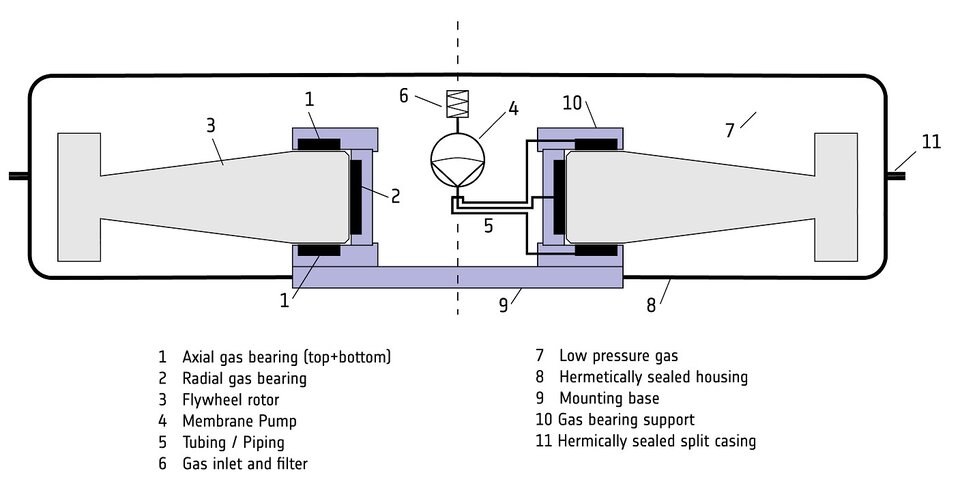Gas bearing system
| 767 - Abstract: |
| The present invention proposes a novel bearing system consisting of a static gas bearing driven by an ultrasonic membrane pump. The gas bearing offers low mechanical noise and excellent lifetime. Its distinct features make it particularly suited for the use in spacecraft attitude control actuators, for example Reaction Wheels, Momentum Wheels, or Control Moment Gyroscopes. ESA is looking for partners who would be interested in licensing and implementing this patent. |
Description:
The peculiarities of space make the bearing choice in spacecraft difficult. Commonly encountered requirements are a maintenance-free operation for more than a decade, the tolerance against the degradation of fluid lubricants due to outgassing, radiation and other effects, the need for low friction caused by limited electrical power, and robustness against the high loads that the bearing has to sustain during the launch of the spacecraft.
State-of-the-art Reaction Wheel technology is mainly based on rolling element bearings, which have a number of disadvantages:
- The tribological contact between ball, raceways and cage requires constant lubrication.
- The small contact area between raceways and rolling elements leads to high Hertzian contact pressures. Ball bearings are consequently sensitive to overload conditions which could deform either the rolling elements or the raceways.
- Ball bearings provide little mechanical damping through their direct ceramic-to-metal or metal-to-metal contact, transmitting (unwanted) mechanical vibrations.
- Manufacturing tolerances of rolling element bearings cause unwanted mechanical vibration and noise.
- The lubrication function of the liquid lubricant is only guaranteed above a threshold speed of approximately 200 rpm.
To overcome those disadvantages, this gas bearing system is presented. Figure 1 illustrates the elements of the invention, which consists of a combination of:
- A static gas bearing.
- An ultrasonic pump (located inside the sealed compartment) as gas supply.
-
A hermetically sealed compartment.
For operation in the vacuum conditions of space, a hermetically sealed housing is required to maintain the working gas present throughout the lifetime of the spacecraft. Potential gas leakage can be avoided by reducing the number of flanges and parts to an absolute minimum. In any case, a sealed access lid is required to allow the assembly and repair of components inside the housing. -
A low pressure, low viscosity gas inside the compartment, to minimize areodynamic losses.
A reduction in gas pressure will not only reduce aerodynamic losses, but also reduce the absolute pressure at the pump inlet.
Innovations and advantages:
- No fluid lubrication is required, avoiding any problem stemming from lubricants such as lubricant loss, evaporation, degradation, creep.
- Excellent dynamic behaviour.
- The vibration and noise emission of the gas bearing Reaction Wheel is 10x – 100x lower than the emission of a ball bearing Reaction Wheel.
- Friction torque noise is absent in gas bearings, leading to a better spacecraft pointing stability.
- Allow the reaction wheel to operate at higher speeds than +/- 200 rpm while maintaining good stability and performance.
- Practically unlimited lifetime due to the absence of physical rotor-stator contact.
- Considerably simpler to build than Magnetic Bearing Reaction Wheels as the part count is lower, the manufacturing requires standard tools and processes and the assembly process can be automated.
- The electronics for the micropump are considerably simpler than the one for a Magnetic Bearing Reaction Wheel.
- Cheaper and lighter than Magnetic Bearing Reaction Wheels.
Domain of application:
For many mission types the reduction of microvibration is a key aspect to achieve mission objectives. This includes various Earth observation, Science and (optical) telecommunication missions, i.e. missions with stringent fine pointing requirements.
A gas bearing type reaction wheel, if successfully qualified, would be a very attractive solution, since it would be less bulky, less complex, but more performant than current concepts.
Further, the combination of a vibrationless micropump and a static gas bearing could be interesting in the field of precision engineering, specifically in applications where the supply of pressurized gas for gas bearings is difficult to achieve. These could be autonomous sliders or bearings on flat floors etc.


